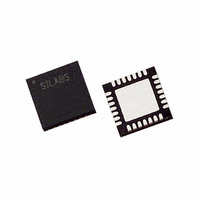C8051F321R Silicon Laboratories Inc, C8051F321R Datasheet - Page 102

C8051F321R
Manufacturer Part Number
C8051F321R
Description
IC 8051 MCU 16K FLASH 28MLP
Manufacturer
Silicon Laboratories Inc
Series
C8051F32xr
Datasheet
1.C8051F320R.pdf
(256 pages)
Specifications of C8051F321R
Core Processor
8051
Core Size
8-Bit
Speed
25MHz
Connectivity
SMBus (2-Wire/I²C), SPI, UART/USART, USB
Peripherals
Brown-out Detect/Reset, POR, PWM, Temp Sensor, WDT
Number Of I /o
21
Program Memory Size
16KB (16K x 8)
Program Memory Type
FLASH
Ram Size
2.25K x 8
Voltage - Supply (vcc/vdd)
2.7 V ~ 3.6 V
Data Converters
A/D 13x10b
Oscillator Type
Internal
Operating Temperature
-40°C ~ 85°C
Package / Case
28-VQFN Exposed Pad, 28-HVQFN, 28-SQFN, 28-DHVQFN
Lead Free Status / RoHS Status
Contains lead / RoHS non-compliant
Eeprom Size
-
Other names
336-1067-2
- Current page: 102 of 256
- Download datasheet (4Mb)
C8051F320/1
10.3. External Reset
The external /RST pin provides a means for external circuitry to force the device into a reset state. Asserting an
active-low signal on the /RST pin generates a reset; an external pull-up and/or decoupling of the /RST pin may be
necessary to avoid erroneous noise-induced resets. See Table 10.1 for complete /RST pin specifications. The PINRSF
flag (RSTSRC.0) is set on exit from an external reset.
10.4. Missing Clock Detector Reset
The Missing Clock Detector (MCD) is a one-shot circuit that is triggered by the system clock. If more than 100 µs
pass between rising edges on the system clock, the one-shot will time out and generate a reset. After a MCD reset, the
MCDRSF flag (RSTSRC.2) will read ‘1’, signifying the MCD as the reset source; otherwise, this bit reads ‘0’. Writ-
ing a ‘1’ to the MCDRSF bit enables the Missing Clock Detector; writing a ‘0’ disables it. The state of the /RST pin
is unaffected by this reset.
10.5. Comparator0 Reset
Comparator0 can be configured as a reset source by writing a ‘1’ to the C0RSEF flag (RSTSRC.5). Comparator0
should be enabled and allowed to settle prior to writing to C0RSEF to prevent any turn-on chatter on the output from
generating an unwanted reset. The Comparator0 reset is active-low: if the non-inverting input voltage (on CP0+) is
less than the inverting input voltage (on CP0-), a system reset is generated. After a Comparator0 reset, the C0RSEF
flag (RSTSRC.5) will read ‘1’ signifying Comparator0 as the reset source; otherwise, this bit reads ‘0’. The state of
the /RST pin is unaffected by this reset.
10.6. PCA Watchdog Timer Reset
The programmable Watchdog Timer (WDT) function of the Programmable Counter Array (PCA) can be used to pre-
vent software from running out of control during a system malfunction. The PCA WDT function can be enabled or
disabled by software as described in
clocked by SYSCLK / 12 following any reset. If a system malfunction prevents user software from updating the
WDT, a reset is generated and the WDTRSF bit (RSTSRC.5) is set to ‘1’. The state of the /RST pin is unaffected by
this reset.
10.7. FLASH Error Reset
If a FLASH read/write/erase or program read targets an illegal address, a system reset is generated. This may occur
due to any of the following:
•
•
•
•
The FERROR bit (RSTSRC.6) is set following a FLASH error reset. The state of the /RST pin is unaffected by this
reset.
102
A FLASH write or erase is attempted above user code space. This occurs when PSWE is set to ‘1’ and a MOVX
write operation is attempted above address 0x3DFF.
A FLASH read is attempted above user code space. This occurs when a MOVC operation is attempted above
address 0x3DFF.
A Program read is attempted above user code space. This occurs when user code attempts to branch to an address
above 0x3DFF.
A FLASH read, write or erase attempt is restricted due to a FLASH security setting (see
Options” on page
109).
Section “20.3. Watchdog Timer Mode” on page
Rev. 1.1
246; the WDT is enabled and
Section “11.3. Security
Related parts for C8051F321R
Image
Part Number
Description
Manufacturer
Datasheet
Request
R
Part Number:
Description:
SMD/C°/SINGLE-ENDED OUTPUT SILICON OSCILLATOR
Manufacturer:
Silicon Laboratories Inc
Part Number:
Description:
Manufacturer:
Silicon Laboratories Inc
Datasheet:
Part Number:
Description:
N/A N/A/SI4010 AES KEYFOB DEMO WITH LCD RX
Manufacturer:
Silicon Laboratories Inc
Datasheet:
Part Number:
Description:
N/A N/A/SI4010 SIMPLIFIED KEY FOB DEMO WITH LED RX
Manufacturer:
Silicon Laboratories Inc
Datasheet:
Part Number:
Description:
N/A/-40 TO 85 OC/EZLINK MODULE; F930/4432 HIGH BAND (REV E/B1)
Manufacturer:
Silicon Laboratories Inc
Part Number:
Description:
EZLink Module; F930/4432 Low Band (rev e/B1)
Manufacturer:
Silicon Laboratories Inc
Part Number:
Description:
I°/4460 10 DBM RADIO TEST CARD 434 MHZ
Manufacturer:
Silicon Laboratories Inc
Part Number:
Description:
I°/4461 14 DBM RADIO TEST CARD 868 MHZ
Manufacturer:
Silicon Laboratories Inc
Part Number:
Description:
I°/4463 20 DBM RFSWITCH RADIO TEST CARD 460 MHZ
Manufacturer:
Silicon Laboratories Inc
Part Number:
Description:
I°/4463 20 DBM RADIO TEST CARD 868 MHZ
Manufacturer:
Silicon Laboratories Inc
Part Number:
Description:
I°/4463 27 DBM RADIO TEST CARD 868 MHZ
Manufacturer:
Silicon Laboratories Inc
Part Number:
Description:
I°/4463 SKYWORKS 30 DBM RADIO TEST CARD 915 MHZ
Manufacturer:
Silicon Laboratories Inc
Part Number:
Description:
N/A N/A/-40 TO 85 OC/4463 RFMD 30 DBM RADIO TEST CARD 915 MHZ
Manufacturer:
Silicon Laboratories Inc
Part Number:
Description:
I°/4463 20 DBM RADIO TEST CARD 169 MHZ
Manufacturer:
Silicon Laboratories Inc










